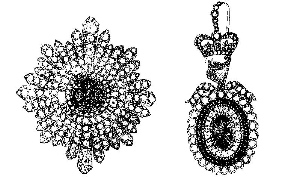Irish Crown Jewels
|
|
The Insignia of the Knights of St. Patrick, commonly known as the Irish Crown Jewels, was a set of jewels worn by the sovereign at the installation of Knights of the Order of St. Patrick (officially the 'Illustrious Order of St. Patrick' , the Irish equivalent of the English Order of the Garter and the Scottish Order of the Thistle. The theft of the 'Irish Crown Jewels' in Dublin, Ireland in 1907 remains a famous mystery that is still discussed. The Irish Crown Jewels were never found.
King George III instituted the Order of St. Patrick in 1783. The Irish Crown Jewels were the insignia of the Order, and consisted of two items: a star and a badge, each composed of rubies, emeralds and Brazilian diamonds.
In 1903, the jewels were transferred to a safe, which was to be placed in the newly constructed strong room. The new safe was too large for the doorway to the strong room, and Arthur Vicars, the Officer of Arms of Dublin Castle, instead stored the jewels in his office. Seven latch keys to the door of the Office of Arms were held by Vicars and his staff, and two keys to the safe containing the insignia were both in the custody of Vicars.
The jewels were discovered missing on 6 July 1907, four days before the State Visit of King Edward VII and Queen Alexandra. The theft is reported to have angered the King (who allegedly exclaimed "I want my jewels!") but the visit went ahead.
Vicars refused to resign his position as Officer of Arms, and similarly refused to appear at a Viceregal Commission into the theft (the Commission did not possess powers to subpoena witnesses) held from 10 January 1908. Vicars argued for a public royal inquiry in lieu of the commission, and publicly accused his second in command, Francis Shackleton, of the theft, who was suspected of being blackmailed on account of his homosexuality, homosexual behaviour being a criminal offence at the time.1 Shackleton was exonerated in the commission's report, and Vicars was found to have "not exercise[d] due vigilance or proper care as the custodian of the regalia'. Vicars met a sad end in disgrace: on 14 April 1921 he was shot dead by IRA militia. The commission's report has been the subject of critical review in recent times (see external link, below) and there has been recent calls in the Republic of Ireland for a centennial enquiry into the crime.
It is believed that the Irish Crown Jewels have never been recovered. It has been rumoured that in 1927 the Irish Crown Jewels were offered for sale to the Irish Free State for £5000 and that they were bought back on then prime minister W.T. Cosgrave's orders, with the instructions that the fact that the Irish state owned them was not to be revealed, for fear of criticism from republicans and because of the tight budgetary situation in the Irish Free State. However an extensive search in the Irish National Archives has failed to find any evidence that they were bought or if so, what happened to them subsequently. (The Irish state until the 1940s did have some of the Russian Crown Jewels which were used as collateral for a loan given to the Russian Republic by the Irish Republic in or around 1920. It is possible the rumour about the state possessing the Irish Crown Jewels grew because it was known that some crown jewels were stored in Government Buildings in Dublin, people naturally presuming that they must be the Irish crown jewels.)2
The Irish Executive Council under W.T. Cosgrave chose not to keep appointing people to the Order when the Irish Free State left the United Kingdom in 1922. Since then, only two people have been appointed to the Order. Both were members of the Royal Family. The then Prince of Wales (the future King Edward VIII and later Duke of Windsor) was appointed with the agreement of W.T. Cosgrave in 1928 while his younger brother, Henry, Duke of Gloucester was appointed with Eamon de Valera's agreement in 1934. The Duke of Gloucester at his death in 1974 was the last surviving member of the Order. It has however never actually been abolished and its resurrection has been discussed in Irish government circles on a number of occasions.
Footnote
1 Rumours of a homosexual ring in Dublin Castle were linked to claims about the theft. It was variously rumoured that Shackleton and/or Vicars were being blackmailed on account of their orientation, they or others in the Castle facilitating the theft to pay off the blackmailers or to "expose" Vicars' rumoured sex-life through an inquiry into the theft. The claim of homosexual rings in Dublin Castle was nothing new. One nationalist MP during the lord lieutenancy of the 5th Earl Spencer in the 1880s famously nicknamed the Lord Lieutenant's Dublin Castle administration Sodom and Begorrah.
2 The new Russian Republic, which was seriously low on funds, apparently sought the loan from the UDI Irish Republic, whose Finance Minister, Michael Collins, had become internationally famous for his fundraising for the unofficial Irish state. The Jewels were placed in a safe in Government Buildings and promptly forgotten about, though the existence of some crown jewels somewhere was rumoured. They were rediscovered in the 1940s by accident and sent to Moscow. It is not known if Josef Stalin repaid the loan.
Additional Reading
- Tim Coates (ed.), The Theft of the Irish Crown Jewels (Tim Coates, 2003) ISBN 1843810077
External links
- Dublin Castle's commentary on the theft (http://www.dublincastle.ie/history12.html)
- Analysis of the theft and key suspects. (http://homepage.eircom.net/~seanjmurphy/irhismys/)Template:Crowns

